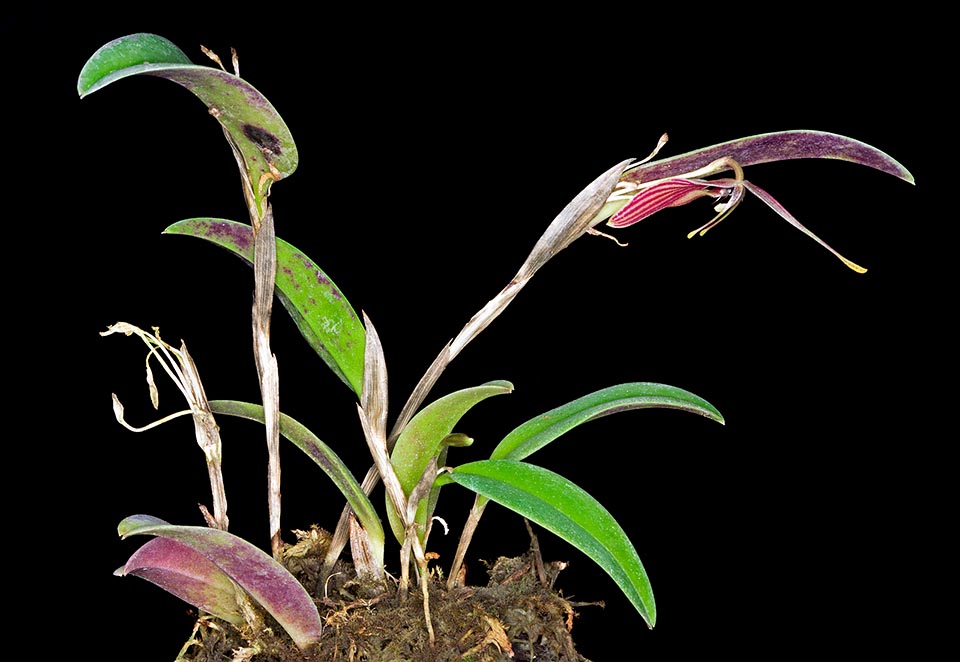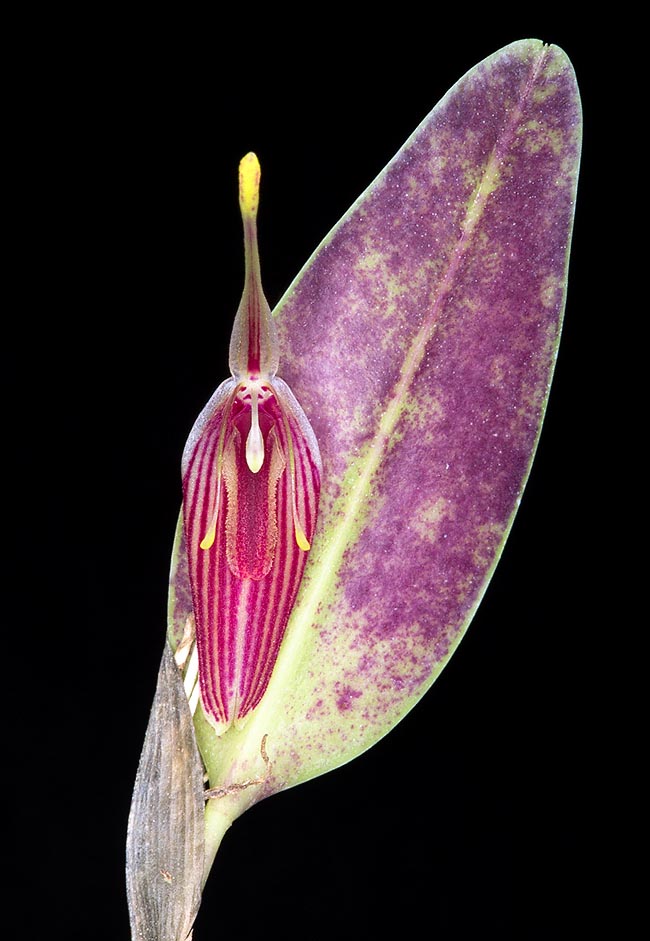Family : Orchidaceae

Text © Pietro Puccio

English translation by Mario Beltramini

Restrepia limbata is a cespitose epiphyte, native to Colombian forests between 2000-2200 m of altitude. Unusual flowers and leaves with violaceous hues on the lower page © Giuseppe Mazza
The specie is native to Colombia where it lives on the trees of the humid forest around the 2000-2200 m of altitude.
The genus is honoured to the Colombian naturalist and politician José Manuel Restrepo Veléz (1781-1863); the specific name is the Latin adjective “limbatus, a, um” = edged, with reference to the flowers.
The Restrepia limbata Luer & R. Escobar (1982) is a cespitose epiphyte species with creeping rhizome and unifoliate thin stems, erect, 5-8 cm long, covered per all their length by imbricate sheaths.

It would deserve a better horticultural diffusion due to the easy growth with an almost continuous blooming © Giuseppe Mazza
Ovate-elliptic erect leaves with acute apex, 4-6 cm long and 1,5-2 cm broad, coriaceous, of dark green colour above, with violaceous shades below.
The inflorescences, on an about 3 cm long thin peduncle, generate from the back of the base of the leaf, are produced in succession for a long period of time and carry only one flower. Dorsal linear-lanceolate sepal, thinned, ending in a small enlargement similar to a drop, about 2,5 cm long and 0,3 cm broad, of whitish colour with purple red longitudinal striae, lateral oblong-elliptic sepals merged almost up to the apex forming almost a single sepal (synsepalous), 2,2-2,5 cm long and 0,9-1 cm broad, of whitish colour with purple red longitudinal striae.
Filiform petals with a small enlargement at the apex similar to a drop, about 1,5 cm long, whitish with a thin purple stria at the base, trilobate labellum, about 1 cm long and 0,3 cm broad, with short and thin lateral lobes and oblong median lobe with slightly bilobate apex, fleshy, warty, of purple colour. Thin column, arcuate, dilated towards the apex, about 0,4 cm long.
It reproduces by seed, in vitro, and by division, with each section provided of at least 3-4 stems, and through the young plants that at times it produces at the base of the leaves (in jargon “keiki”, which in Hawaiian means “figli”) that can be removed when they have formed a good radical apparatus; young plants can be obtained also from a portion of stem with leaf inserted in sphagnum maintained humid, after some months at the base of the leaf will get a new plant.
Species with an almost continuous flowering forming quickly dense tufts, little diffused in spite of its ornamental characteristics and the facility of cultivation. It requires a partially shaded position, intermediate temperatures with lowest winter night temperatures not under the 12 °C, high humidity, 70-80 %, and constant ventilation. It can be mounted on pieces of trunks, bark or rafts of various nature, covered by sphagnum to maintain the humidity at the roots, or cultivated in pot with a compost that may be formed by finely sliced bark fragments and charcoal with addition of sphagnum. The watering must be regular, as not having a precise rest time, only slightly reduced in winter, but without ever allowing the substratum to dry up completely, utilizing rainwater, by reverse osmosis or de-mineralized.
The species is inscribed in the appendix II of the CITES (species whose trade is internationally ruled).
